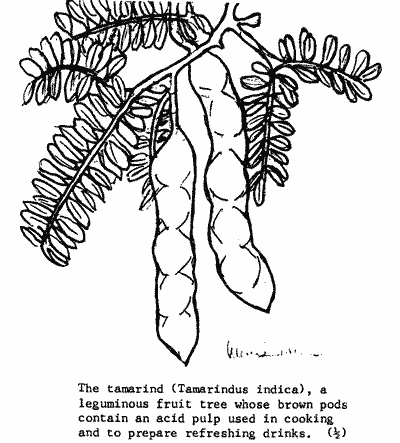
TAMARIND
SCIENTIFIC NAME: Tamarindus indica
FAMILY: Leguminosae
Tamarindus indica L - the tamarind - belongs to the family Leguminosae, a family which includes between 450-500 genera and several thousand species. In the Philippines, there are some 320 genera and 12,000 species. In some parts of the Philippines, tamarind is quite an important crop, although its culture has never developed into an industry.
Its fruit and other parts have varied food and medicinal uses. In terms of export potential, the Tamarind shows great promise. In 1977, the country exported some 30,600 kilos of glacéd or crystallized tamarind to Canada, USA, Guam and Hawaii valued at around $43,400.
The tree is a native to Asia and America, but is now found in all tropical countries. There is no known record of the first introduction of tamarind into the Philippines, but it is well-established in the country as a back yard tree.
The tree is a handsome evergreen, medium- to large-sized tree of 12-25 metres in height with a dense top and a trunk circumference measuring about 7.5 metres.

The leaflets are 1-2 centimetres long and fold closed in the evenings. The strap pod is 8-15 cm in length and contains three to five black seeds which, in the ripe stage, have a thin brittle, loose shell enclosing a soft, brownish, sticky acid/sweet and aromatic pulp. There are no known standard varieties in the Philippines or in other countries, but in Laguna, several trees have been found bearing sweet fruit. The pods were 20-22 centimetres long, 4cm wide and weighed 40-50 grams, and contained 6-7 seeds.
The tree prefers a deep, well-drained sandy or clay loam soil with high organic content and grows best in areas with well-distributed rainfall, although it will also grow in areas with a pronounced dry season.
Tamarind may be propagated by seeds, by bud grafting and marcotting. In the Philippines, most trees have been grown from seed, but this is not recommended as they do not produce true-to-type. Cleft grafting is mostly recommended for large scale propagation. Asexually propagated plants may be planted at 8-10 metre distances.
There is no information available on the nutritional requirements of the tamarind. It will fruit even without fertilization.
About 100-200 grams ammonia sulphate is applied per tree a month after planting and a similar amount at the end of the rainy season. When trees are starting to bear, an application of 500 grams is given twice yearly, whilst a full-bearing tree may need at least 2 kg per year.
There are no major diseases of tamarind, although a few insect pests may inflict some damage to the leaves and fruit.
DATE: May 1981
* * * * * * * * * * * * *
